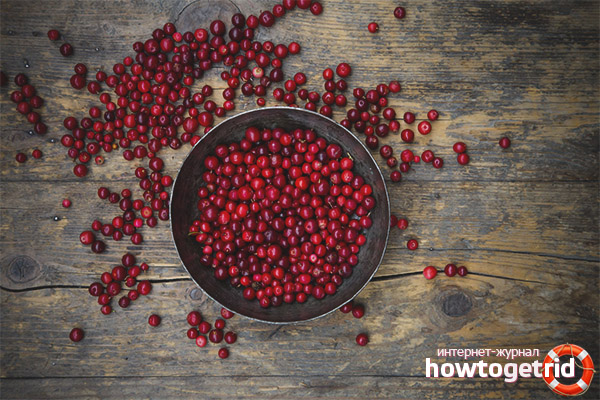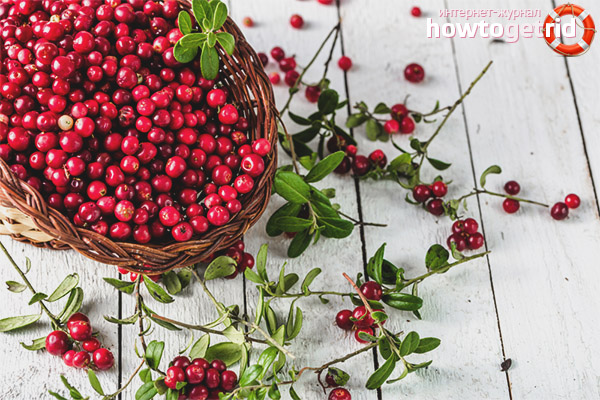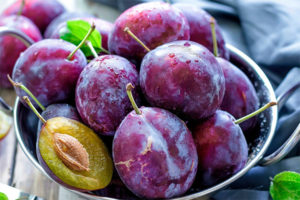The content of the article
In the cold season, the body needs additional immunity support to resist colds and viruses. Therefore, when the time comes for the prevention or even treatment of the disease, we recall all the natural antiseptics and sources of vitamin C known to us - lemons, honey, raspberries, ginger, onions and garlic. But few people think about the benefits of wild berries for colds. But frost-resistant autumn berry is able to protect the body and saturate it with vitamins even in a thermally processed form! Today we will talk about lingonberries - ruddy forest beauty, eliminating acute respiratory infections in a couple of tricks.
What is useful lingonberry
Lingonberry is a wild forest berry of crimson-red color, ripening in the fall. It grows with an evergreen shrub, the fruits are collected in neat clusters. Smaller cranberry berries have a pleasant sweet and sour taste with a characteristic bitterness and an ethereal “mint” flavor.
Not only the fruits are useful, but also the leaves of the plant, which have a strong antibacterial and anti-inflammatory effect, a diuretic and choleretic effect.
The berry is rich in vitamins A, C, E, as well as potassium, manganese, iron, phosphorus, calcium, tannins and natural sugars. In a fresh and prepared form, lingonberry is able to "raise" the body with acute respiratory, viral diseases, soothe the arising pain in the joints, relieve migraines and normalize digestion.
Among the useful properties of lingonberries:
- fight against viruses and infections;
- removal of edema and inflammation;
- removal of excess salts and toxins from the body;
- choleretic effect, which is useful for restoring the body after taking medication;
- antipyretic effect;
- control of perspiration and metabolic processes during intoxication;
- strengthening of nervous tissue and vascular walls;
- anemia treatment;
- improving digestion and absorption of nutrients from food;
- improving vision and protecting the skin from the weather;
- general immunity support.
How to use lingonberry in the treatment of acute respiratory viral infections
To cure a cold in winter, concentrated juices, fruit drinks, fruit drinks, alcohol tinctures, preserves, jams, marmalade are prepared from the berry, and the whole berry is soaked and caramelized. In addition, lingonberries can simply be frozen or dried for long-term storage. Then it can be used in dishes all winter.
The refined tart taste makes lingonberry drinks a good way to quench your thirst during a fever and just a delicious addition to the table. Fragrant berries and their leaves are placed in tea or brewed as an independent infusion. The high content of pectin allows you to get excellent jelly-like desserts from berries. And the essential and antimicrobial components allow you to store blanks with lingonberries for several years.
Contraindications
Lingonberries are not given to children under 7 years of age, since radioactive substances can accumulate in it. It is advisable to buy berries collected in ecologically clean areas.
Since lingonberry drugs are recommended for use on an empty stomach for treatment, people with pancreatitis, gastritis and other gastrointestinal diseases need to be very careful with the berry and not start treatment without consulting a doctor.
Also, diuretic and astringent components found in berries should not be combined with the use of anticoagulants or with renal failure.Cowberries are used with caution in case of hypotension due to its ability to reduce temperature and lower blood pressure.
Eat only ripe dark red juicy berries. Unripe fruits can cause indigestion and indigestion.
Useful recipes with lingonberries
To control the water balance in the body for colds, drink lingonberry decoctions and teas. This will help relieve sputum and improve expectoration, relieve irritation of the mucous membranes of the respiratory tract, remove toxins from exposure to viruses, relieve pain, reduce fever, strengthen muscles and joints, and protect the liver.
Infusions
The mood of the leaves and shoots is as follows: for 1 cup of boiling water take 1 tbsp. dry raw materials. Stand for 30 minutes, filter. Take 2 tbsp. before meals 3-4 times a day during colds and 1-2 times for prevention.
To reduce cough and relieve swelling from the tonsils, gargle with such an infusion: 4 tbsp. berries per 0.5 liters of boiling water. Infusion is heated in a water bath for about half an hour, not allowing to boil, and gargle 2 times a day. You should not store such a drug; prepare it on the day of use in order to immediately use it up.
Lingonberries collected during flowering can be boiled in a decoction, 800 ml of water are taken per 100 g of product and kept on low heat for 20 minutes, then they insist for about 6 hours. After this, the broth is filtered, and I take 50 g with food.
Teas
To prepare a delicious hot drink of berries, mash them without sugar and boil mashed potatoes with water in a ratio of 100 g of lingonberry per liter of liquid. Tea is kept on fire for 5 minutes, then insisted for about half an hour, filtered. Drink a decoction with honey to taste. You can add cinnamon or cloves to tea to taste.
You can just make tea from the leaves. Take 2-3 tablespoons of raw materials and pour a liter of boiling water, then let it brew a little. They drink a drink with the addition of lemon, spices, berries (raspberries, cranberries, currants) and honey or sugar.
For example, make such a decoction: rosehip, raspberry, currant, nettle and lingonberry leaf. A mixture of raw materials7 prepare from equal parts of components, for 1 tbsp. Boiling water is needed 1 tbsp. mixtures. The broth is boiled for 10 minutes, after which they insist. For medicinal purposes, drink half a glass three times a day. As a tonic, drink diluted in moderation.
Preserves
To keep the berries intact and used in desserts, pour the picked lingonberries into a sterilized jar, 2/3 or 3/4 and pour boiling water. Let it brew, then pour the lingonberry water into a saucepan, add sugar to taste and boil the syrup. After boiling sugar, pour the berries and roll up the mixture. Spice lovers can add cloves, cinnamon or peppermint to the berries.
Classic lingonberry jam is prepared in a similar way: the berry is ground with sugar. For 1 kg of berries, you can take 400-700 g of sugar - to taste. Puree is heated over low heat until the sugar turns into a syrup, brought to a boil. Then rolls into prepared banks.
Lingonberry goes well with cranberries, cloudberries, blueberries, cherries, pomegranates. In stewed fruit, berries can be added to apples or peaches.
To make tea for colds with lingonberry jam, take 2-3 tablespoons of dessert, add a slice of ginger, a pinch of cinnamon and mint, you can also use cardamom and zest of lemon or orange. Pour boiling water over the mixture, let it brew for 5-7 minutes and drink it warm.
Video: lingonberry fruit juice - the best cure for colds












Submit